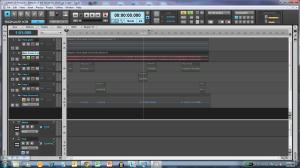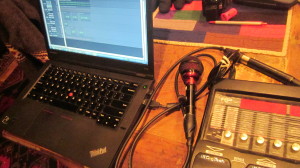
Keepers of the Streak Part 2
I reported on this blog not long ago about a session I did for an ESPN movie called “Keepers of the Streak.” I spent Christmas in Idaho, and not long after I arrived there I got a call for a second session for this movie. The composer, Brian Keane, specifically asked if I could do acoustic tracks, and mentioned that he wanted something along the line of Toots Thielemans, meaning of course some cool-toned chromatic harp.
I keep a Digitech RP355 loaded with my patch set at my place in Idaho, along with a Peavey KB2 amp and a few other things. On this trip I’d also brought an Audix Fireball V mic, a CX12 chromatic in E (minor 6th below a standard 12-hole C chromatic), 18 assorted diatonics, and a looper (which was not needed for this session, but still). I also had my laptop, which runs Cakewalk Sonar X3 recording software. In general, I was sufficiently geared-up for the gig.
Brian sent me mp3s for the main and harp guide tracks for the two pieces he wanted me to play on. Usually Brian sends PDFs for the harp parts, too, but this time he suggested that I just learn the parts from the guide tracks. I loaded the mp3s into Sonar, and all was ready.

The Mic: Audix Fireball V
The real question in “can you do acoustic tracks?” is “how good does your room sound?” Fortunately, with an Audix Fireball V, you can record very nice acoustic tracks without letting the room into the recording. Handholding the Fireball V sounds good, clear and present, with no proximity effect, and it’s a very nice solution to the problem of recording harmonica in a dodgy space.
The Audio Interface: Digitech RP355
For the audio interface I used the Digitech RP355, connected to the laptop via USB. The RP355 might have been used in other contexts to dramatically change the sound of the harp. On the initial sessions for “Keepers of the Streak,” I’d used an RP360XP running a patch I created called “GA40” (in honor of the Gibson amp of the same name) to produce an amped-up harp tone. This time around, the composer wanted an acoustic sound. So I set up a patch on the RP355 called DIRREC (for “Direct Recording”) that used a direct amp model set to a level of 91, with a direct cabinet, no other FX. The Direct amp model essentially passes the signal straight through from the RP’s inputs to the outputs, with added (clean) gain if desired, so it’s perfect for recording an “acoustic” sound. Needless to say, it’s nice to have an FX device in the input chain that offers any harp sound from squeaky clean to massively distorted and effected on demand, and even nicer when you get all that plus a solid USB audio interface in the same box.
In initial testing I found that a little too much slide noise was coming from the CX12 in E that I used for the session, so I used EQ on the input channel of my recording software (SONAR X3) to take out the frequencies below 200 Hz, where I thought a lot of the noise was located. I also took the slide out of the CX12, washed it, wet it again, and put it back into the harp, which seemed to make things smoother and quieter.

Three Harps for Two Pieces
One of the pieces, a western swing 32-bar number with Rhythm changes on the bridge, was in the key of A, which on an E chromatic is the equivalent (in terms of the note layout) of F on a C chromatic. On a C chromatic the key of A involves 3 sharps as opposed to the one flat required on the E harp, and flats are generally easier on the chromatic. All that by way of saying that the E chromatic worked nicely on this piece (and it had better, since it was the only chromatic I had with me). The other piece was a somewhat free-rhythm blues riff in E minor, and I used two harps to play it: a Lee Oskar Melody Maker in G, and a Seydel Session Steel in A. I alternated the harps, using the Session Steel where the written part dictated a prominent C# that didn’t sound strong played as a bend on the Melody Maker. (When a note is really exposed, you’ve got to nail the pitch and the timbre precisely to make it work, and that’s too much work for me when I know the audience will have no idea whether it was played on one harp or fifty.) On this second piece, I concentrated on hitting the entrances with the guitar; the rhythm was loose, but the harp still sounded synced-up.
A Few Thoughts About Sessions On the Road
It’s not hard to cut good-sounding tracks on the road if you’ve got the right gear, and the “right gear” comes in a surprisingly compact package nowadays. I travel with a set of 18 diatonic harps, 1-2 chromatics, a Digitech RP loaded with one of my patch sets (if I don’t already have one at my destination), an Audix Fireball mic, various audio and USB cables, and a laptop running Sonar X3. The Sonar program is the most expensive item in the lot, and I could replace it for this purpose if I chose with the excellent freeware program Audacity, which offers plenty of flexibility in simple recording and overdubbing on multiple tracks, without all the cool MIDI, mixing, and mastering tools in Sonar (which generally aren’t needed if you’re cutting raw tracks, as opposed to mixing and mastering). As it happens, I’ve been using Sonar for years for composing and making demos, and I’d have it whether I had Audacity or not. I’m also very familiar with Sonar, and it’s as easy or easier for me to set up something simple like making tracks in Sonar as in Audacity. All that by way of saying that I’m sticking with what I have and what I know best, but if you’re just putting your road kit together, you can save hundreds of dollars by going with Audacity instead of a more-expensive commercial digital audio workstation (if all you really need to do is cut tracks; for mixing and mastering, a DAW is the thing you want).
In terms of capabilities I’d like to enhance, I’d like first to be able to bring more harps more often, because more harps = more flexibility in terms of how I approach my part on a tune, but harps in a road case take up lots of weight and space, and usually I do just fine with what I’ve got in the small case. (If not, I buy a harp to fill the gap with 24-hour delivery.) This setup fills a little less than half of a small suitcase that fits in an overhead rack on an airplane, meaning that in many cases I can travel with my gear and my personal effects in one bag.
The Audix mic and the Digitech RP do double duty in this rig. The mic captures the sound and excludes the room; the RP processes the sound and gets it into the computer. The whole rig is light, powerful, and trivially simple to set up and tear down. What a change from the days, not so long ago, when I routinely carried 35 pounds of gear in a separate suitcase!
Tags In
Related Posts
Leave a Reply
You must be logged in to post a comment.
WHAT’S NEW
Categories
- Audio/Video
- Blog
- Blue Future
- Digitech RP Tricks and Tips
- Discography, CDs, Projects, Info, Notes
- Featured Video
- For the Beginner
- Gallery
- Hunter's Effects
- Hunter's Music
- Huntersounds for Fender Mustang
- Meet the Pros
- More Video
- MPH: Maw/Preston/Hunter
- My Three Big Contributions
- Player's Resources
- Pro Tips & Techniques
- Recommended Artists & Recordings
- Recommended Gear
- Recorded Performances
- Reviews, Interviews, Testimonials
- The Lucky One
- Uncategorized
- Upcoming Performances
- Zoom G3 Tips and Tricks